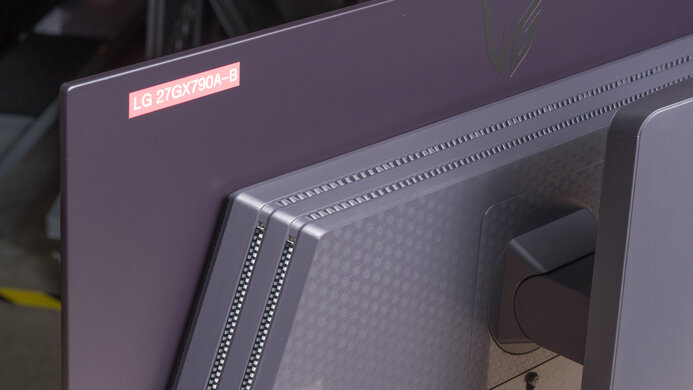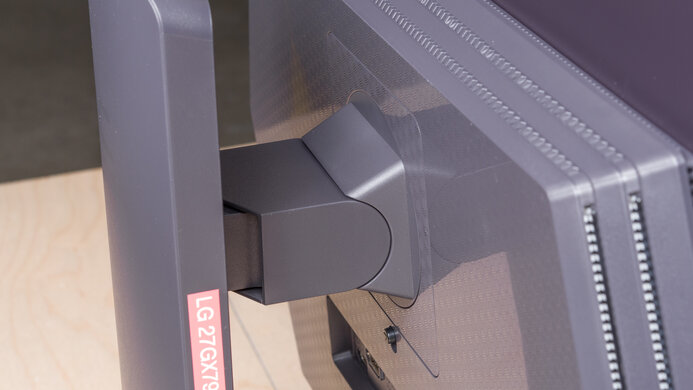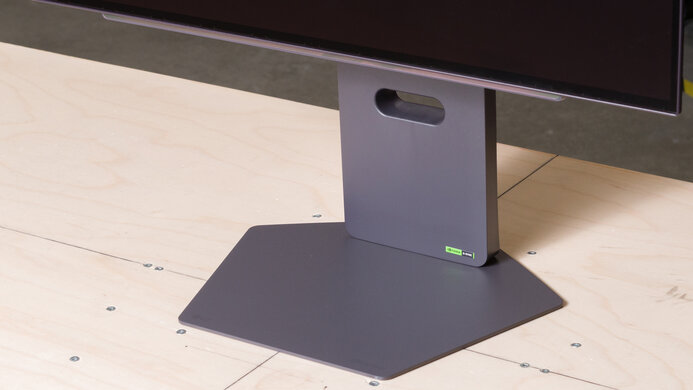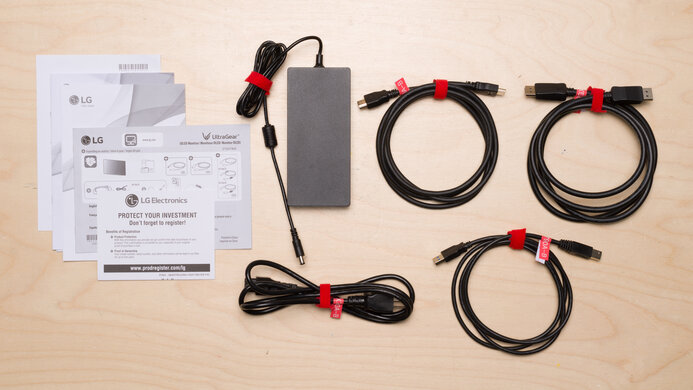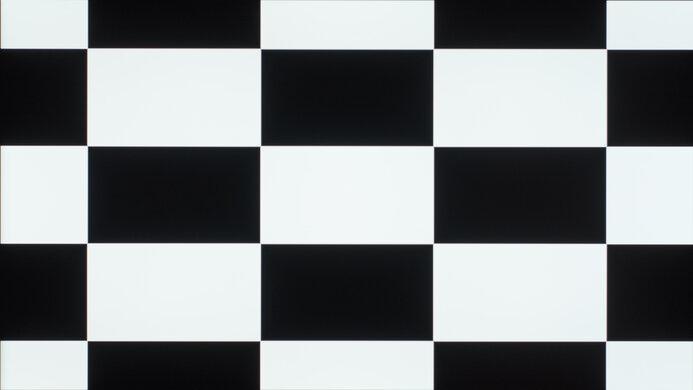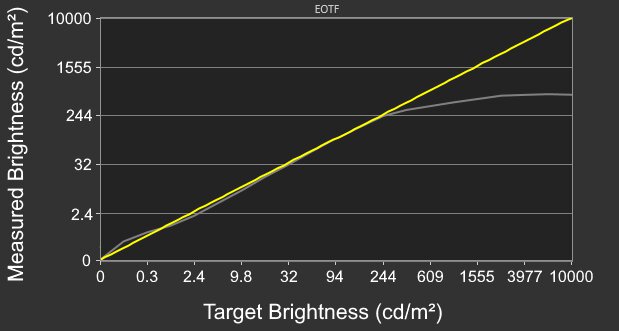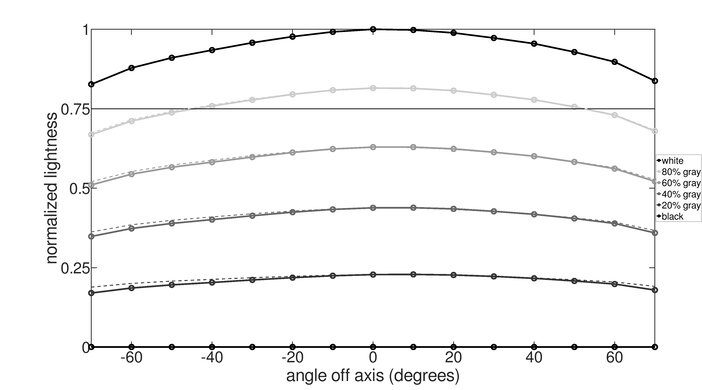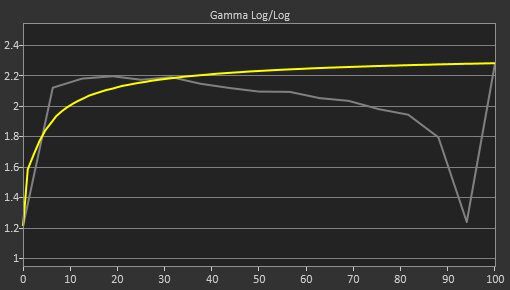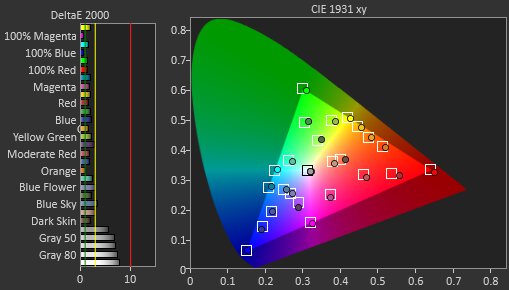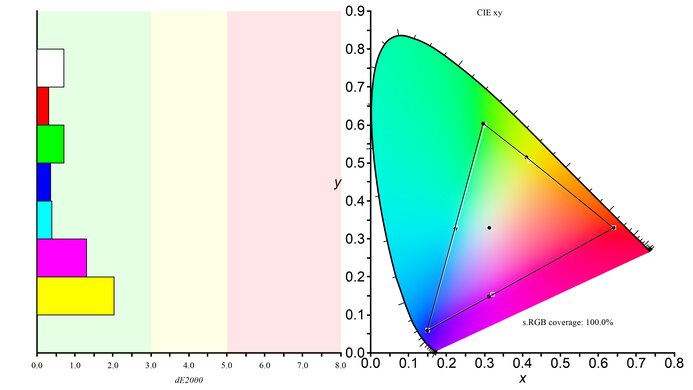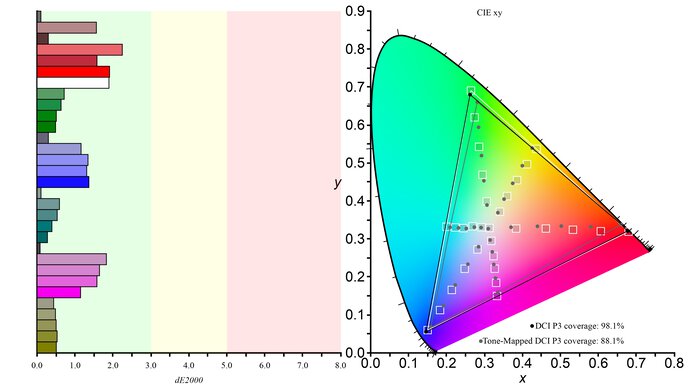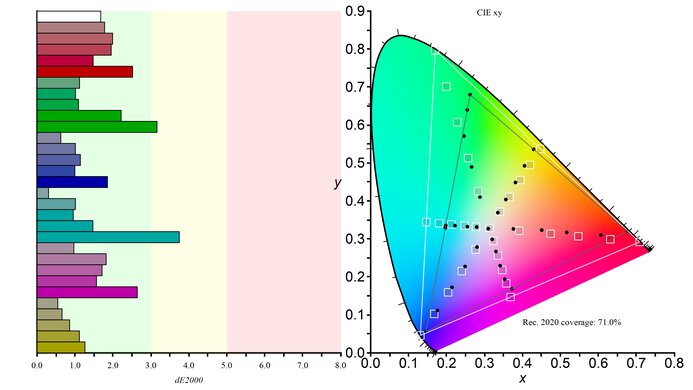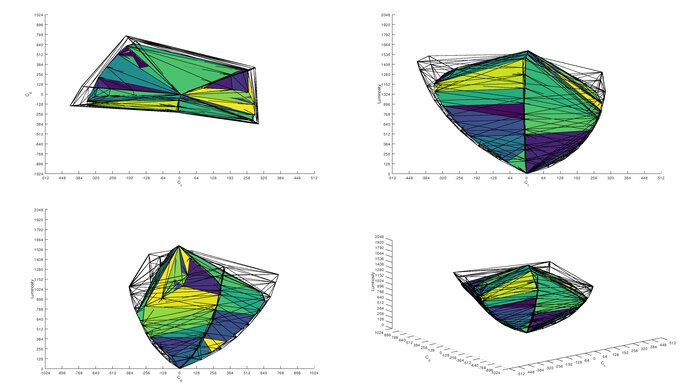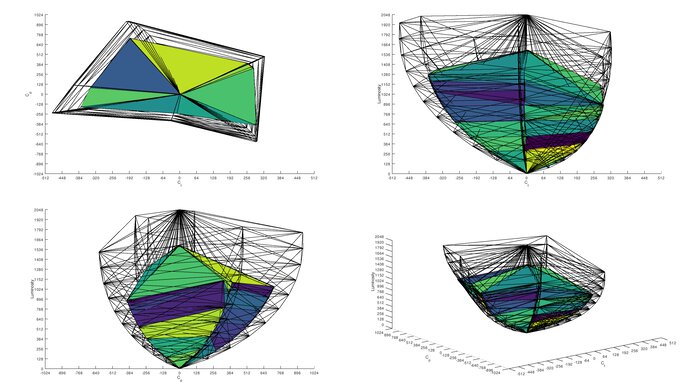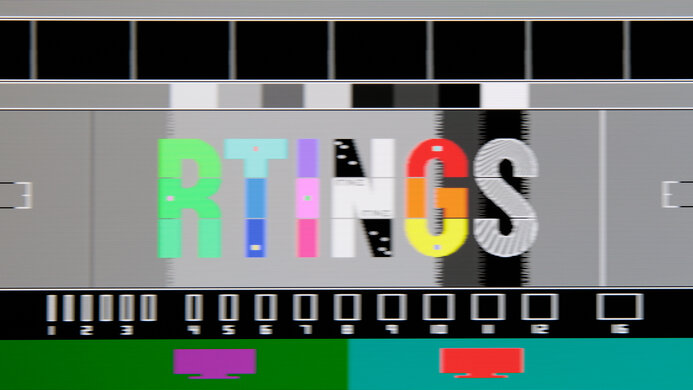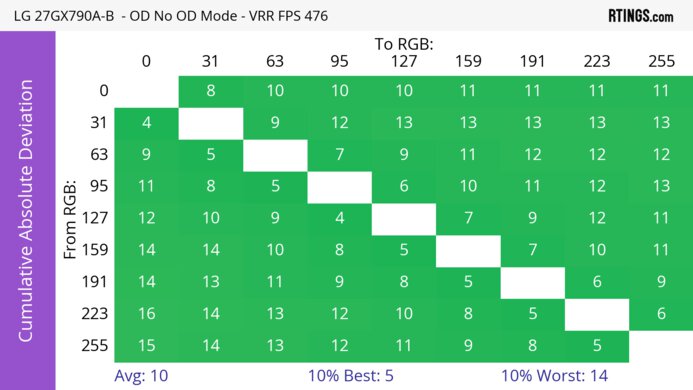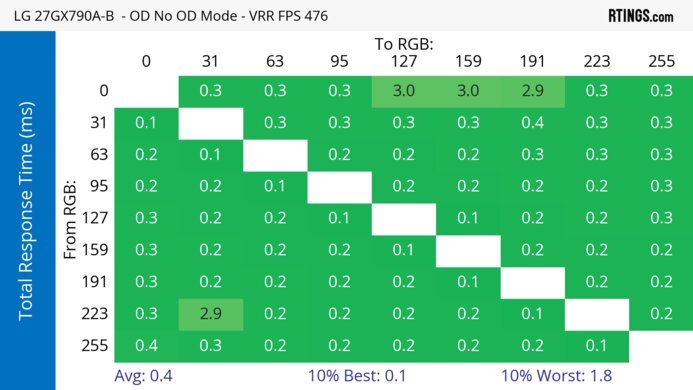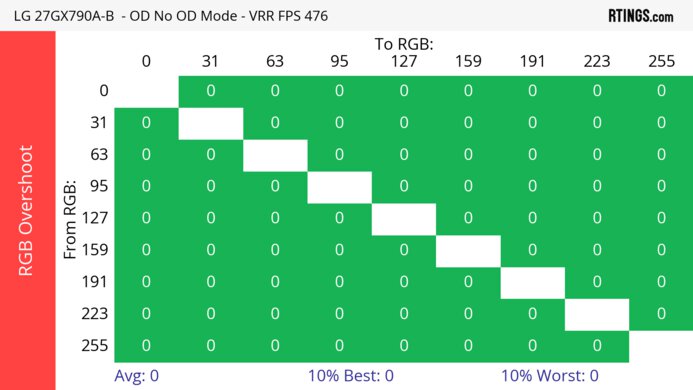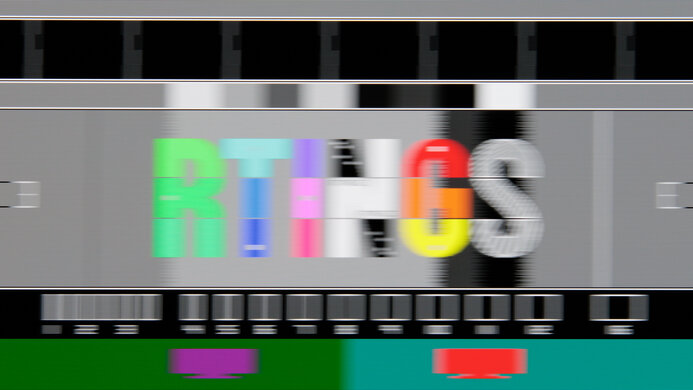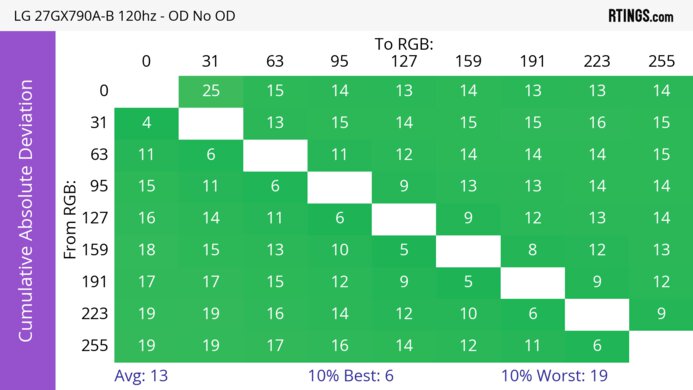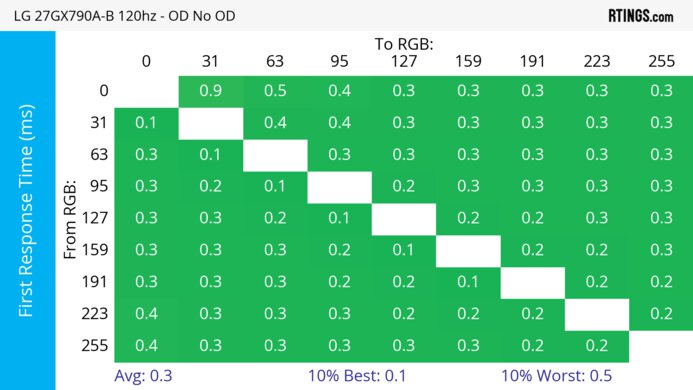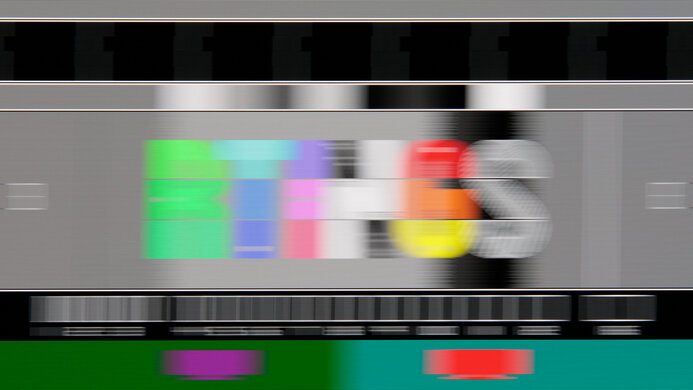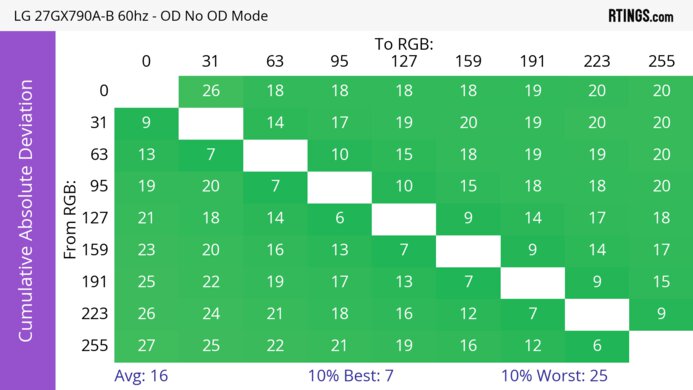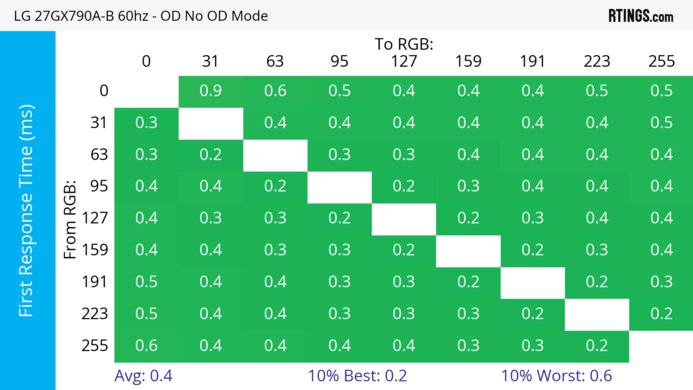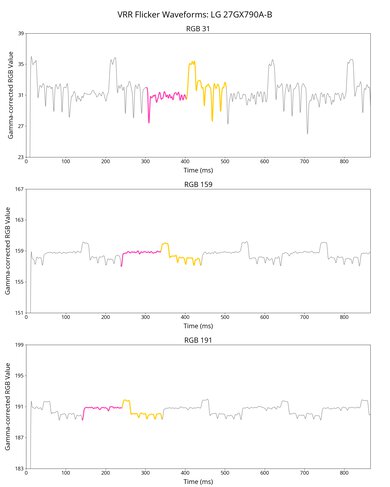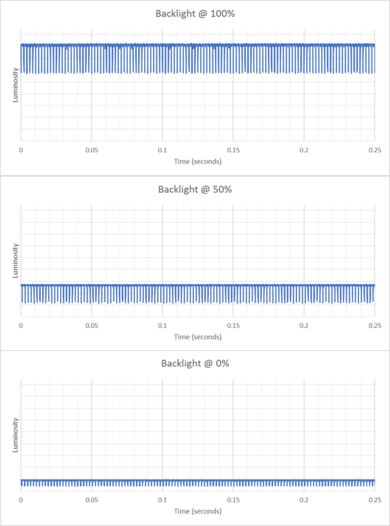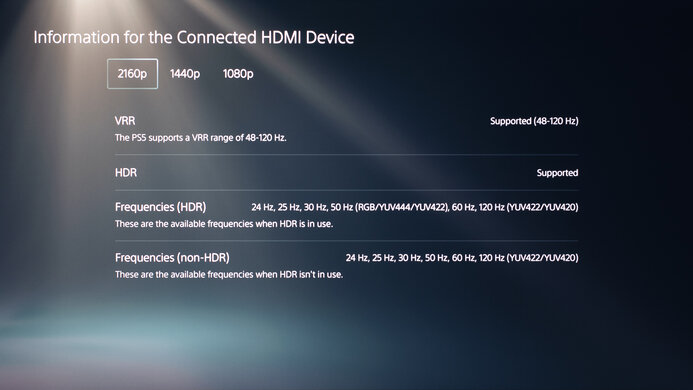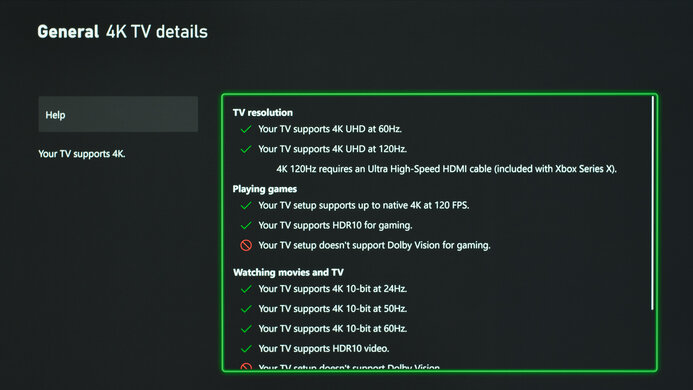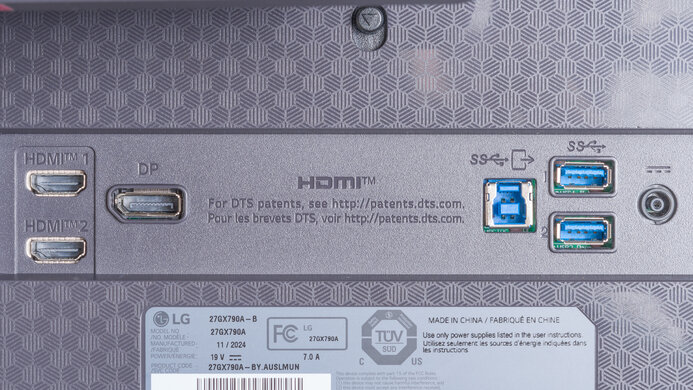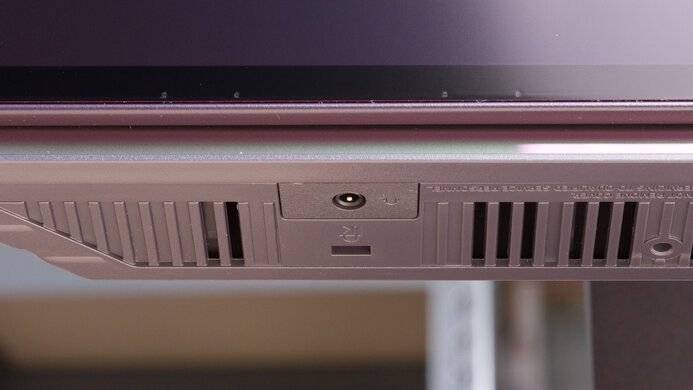The LG 27GX790A-B is a 27-inch OLED gaming monitor with a 1440p resolution and a 480Hz refresh rate. It competes with other monitors with similar specifications, like the Acer Predator X27U F3, the ASUS ROG Swift OLED PG27AQDP, and the Sony INZONE M10S. It supports all VRR formats, has Micro Lens Array+ (MLA+) technology for added brightness, and has HDMI and DisplayPort 2.1 bandwidth. Additionally, it has RGB hexagonal backlighting and DTS Headphone:X for a more immersive gaming experience. Like most OLED monitors, it also comes with some settings to reduce the risk of burn-in associated with OLEDs.
Our Verdict
The LG 27GX790A-B is outstanding for PC gaming. It has a very fast response time, so motion looks crisp, and it has very low input lag. It also supports all VRR formats to reduce screen tearing, though unfortunately, it has noticeable VRR flicker with changing frame rates. It also delivers incredible picture quality, and you can see deep blacks next to bright highlights.
-
Incredibly high 480Hz refresh rate.
-
Supports all common VRR formats.
-
Fast response time for sharp motion.
-
Low input lag.
-
Displays deep and inky blacks.
-
Small highlights pop in HDR.
-
Noticeable VRR flicker.
The LG 27GX790A-B is excellent for console gaming above 60Hz. It has a near-instantaneous response time with remarkably crisp motion. Additionally, its picture quality is incredible, and you can see deep blacks next to bright highlights. It also supports VRR with both consoles. It also has low input lag, as long as you have the firmware updated to its latest version.
-
Supports all common VRR formats.
-
Fast response time for sharp motion.
-
Low input lag.
-
Displays deep and inky blacks.
-
Small highlights pop in HDR.
-
Downscales 4k signals from PS5 & PS5 Pro and Xbox Series X|S.
The LG 27GX790A-B is decent for office use. It has great ergonomics and wide viewing angles, so it's easy to place it in your preferred position or share your screen with others. It also gets bright enough to be visible in a moderately lit room, but it's darker than many other OLEDs and can't overcome glare from a bright window. However, like many other OLEDs, it has some fringing around text. Additionally, it risks burn-in with constant exposure to the same static elements over time.
-
Fantastic reflection handling.
-
Versatile ergonomics.
-
Text not as clear as on IPS or VA displays.
-
Risk of burn-in.
-
Not as bright as many other OLEDs.
-
Can't overcome bright glare.
The LG 27GX790A-B is excellent for editing. It displays a wide range of colors, and it has superb picture quality. Its highlights pop in HDR, and you can see deep blacks next to bright highlights, even in a dark room. However, it's not very accurate before calibration, and it has a risk of permanent burn-in with constant exposure to static elements over time, like from your editing programs.
-
Displays deep and inky blacks.
-
Small highlights pop in HDR.
-
Risk of burn-in.
-
Not as bright as many other OLEDs.
-
Larger highlights are somewhat muted.
-
sRGB mode has pre-calibration accuracy issues.
-
Can't overcome bright glare.
The LG 27GX790A-B has okay brightness. While small highlights pop in HDR, larger highlights don't. Additionally, it can't overcome glare from bright windows, but it's bright enough to be visible in a moderately lit room, even though it's darker than many OLEDs.
-
Small highlights pop in HDR.
-
Not as bright as many other OLEDs.
-
Larger highlights are somewhat muted.
-
Can't overcome bright glare.
The LG 27GX790A has a near-instantaneous response time, resulting in exceptionally sharp motion.
-
Fast response time for sharp motion.
The LG 27GX790A has excellent HDR picture quality. It displays a wide range of colors, as well as deep blacks in a dark room. However, its colors aren't as vivid as on QD-OLED displays.
-
Displays deep and inky blacks.
-
No blooming around bright objects.
-
Bright colors aren't as vivid as QD-OLEDs.
The LG 27GX790A has remarkable SDR picture quality. It displays deep blacks and a wide range of colors.
-
Displays deep and inky blacks.
-
Wide range of colors.
The LG 27GX790A-B has great color accuracy. It has a dedicated sRGB mode, but it has some inaccuracies, and you need to calibrate it for good accuracy.
-
sRGB mode has pre-calibration accuracy issues.
- 9.2 PC Gaming
- 9.0 Console Gaming
- 7.3 Office
- 8.6 Editing
Performance Usages
- 6.7 Brightness
- 9.9 Response Time
- 8.9 HDR Picture
- 9.9 SDR Picture
- 8.4 Color Accuracy
Changelog
-
Updated May 09, 2025:
We changed the Pre-Calibration results to use the results from the sRGB mode instead, as it properly clamps colors to the sRGB color space.
-
Updated May 07, 2025:
We updated the firmware to 3.04, 2.04, which improves the Input Lag at 60Hz.
-
Updated Feb 26, 2025:
We remeasured the accuracy after calibration, this time with Contrast at its default value of '70'.
- Updated Feb 26, 2025: We've converted this review to Test Bench 2.0.1. This includes a new test result for DisplayPort 2.1 Transmission Bandwidth.
- Updated Feb 25, 2025: Review published.
Differences Between Sizes And Variants
We tested the 27-inch LG 27GX790A-B, which is the only size available for this monitor. LG has several similar 27-inch OLED models, but there are significant differences between them, as the table below shows. These results are only valid for this model.
| Model | Refresh Rate | DisplayPort Version | Remote Control |
|---|---|---|---|
| 27GX790A-B | 480Hz | 2.1 | No |
| 27GS93QE-B | 240Hz | 1.4 | Yes |
| 27GS95QE-B | 240Hz | 1.4 | No |
Our unit's label indicates that it was manufactured in November 2024. We tested it with firmware 3.03, 2.04, and retested the Input Lag with firmware 3.04, 2.04.
Compared To Other Monitors
The LG 27GX790A-B is ideally suited to esports gamers, as it has a 1440p @ 480Hz display and an extremely fast response time. It's one of several 480Hz OLED displays that provide a far more responsive feel than IPS or TN gaming monitors. However, while this monitor is in the top tier of competitive gaming monitors, you need to make sure you have the firmware updated for the best input lag at 60Hz. Additionally, since it costs considerably more than 360Hz QD-OLED displays, like the MSI MPG 271QRX QD-OLED, it's primarily worth getting if you want smoother motion.
Also, see our recommendations for the best 27-inch gaming monitors, the best high refresh rate monitors, and the best 1440p gaming monitors.
The ASUS ROG Swift OLED PG27AQDP and the LG 27GX790A-B are both 1440p 480Hz WOLED competitive gaming monitors. The ASUS is a better choice if you're gaming in a brighter room, as it gets brighter in SDR. It also has a black frame insertion feature to reduce persistence blur. However, the LG has fewer bugs and is a better choice if you're looking for a monitor with fewer issues.
The MSI MPG 271QRX QD-OLED and the LG 27GX790A-B are high refresh rate 1440p OLED gaming monitors. The MSI is the better option for most people, as it has slightly sharper text, more vivid colors, and a USB-C port with 90W of power. It also has equally low input lag at its max refresh rate. However, the LG is a better option if you prefer the added smoothness of a 480Hz display.
The ASUS ROG Swift OLED PG32UCDP and the LG 27GX790A-B are OLED gaming monitors with maximum refresh rates of 480Hz. The ASUS is the more versatile option, as it can also display a 4k @ 240Hz signal on its larger 32-inch display. However, the LG is a better option for dedicated esports gamers, as you can reach its 480Hz maximum refresh rate at a higher 1440p resolution.
The Sony INZONE M10S and the LG 27GX790A-B are 1440p 480Hz WOLED displays designed for competitive gamers. Both displays are very similar, and most people should get whichever they can find cheaper. However, if you're looking for every competitive edge, the Sony has a unique mode that enhances the outline of enemies in some FPS games.
The LG 32GS95UE-B and the LG 27GX790A-B are OLED gaming monitors with maximum refresh rates of 480Hz. The 32GS95UE-B offers a more immersive experience, with a larger screen and a more detailed 4k @ 240Hz mode. However, the 27GX790A-B is a better option for competitive gamers, as it can reach a higher 1440p resolution at its maximum refresh rate of 480Hz.
Video
Test Results
The build quality is excellent. While the housing is plastic, it's quite solid, with minimal creaking or flex. However, there is a bit of a gap between the bezel and the display at the bottom of the monitor.
The ergonomics are great, and it's easy to place in your preferred position for a long gaming session. You can also rotate the monitor vertically. The stand has a cutout for cable management, which you can also see up close.
This monitor doesn't have a backlight, so it doesn't require a local dimming feature. However, with a near-infinite contrast ratio, there isn't any blooming around bright objects, and it's the equivalent of a perfect local dimming feature. We still film these videos on the monitor so you can see how the screen performs and compare it with a monitor that has local dimming.
Settings
- Picture Mode: Gamer 1 (after calibration)
- Brightness: 100
- Peak Brightness: High
The SDR brightness is acceptable. It's darker than many OLEDs, but you can still easily see it in a moderately lit room, though it doesn't overcome bright glare.
You can set Peak Brightness to 'Low' or 'Off,' which results in more consistent brightness across different content, but they're dimmer. You can see how these modes affect brightness levels in more detail below:
| Percent Window | Peak Brightness: Low (cd/m2) | Peak Brightness: Off (cd/m2) |
|---|---|---|
| 2% Peak | 273 | 205 |
| 2% Sustained | 272 | 204 |
| 10% Peak | 272 | 204 |
| 10% Sustained | 271 | 203 |
| 25% Peak | 273 | 205 |
| 25% Sustained | 272 | 204 |
| 50% Peak | 274 | 207 |
| 50% Sustained | 272 | 206 |
| 100% Peak | 222 | 208 |
| 100% Sustained | 222 | 207 |
Settings
- Picture Mode: Gamer 1
- Brightness: 100
- Peak Brightness: High
- Smart Energy Saving: Off
The HDR brightness is decent. It gets bright enough to fight glare in most well-lit rooms, and it also makes small highlights pop against the rest of the image. However, it doesn't sustain the brightness with larger highlights. It follows the PQ EOTF curve well, though it has a slow roll-off near peak brightness, so highlights don't get as bright as they could.
If you set Peak Brightness to 'Low' it isn't as bright, as you can see below:
| Scene/Window Size | Peak (cd/m2) | Sustained (cd/m2) |
|---|---|---|
| PQ EOTF | PQ EOTF Chart | |
| Real Scene | 440 | |
| 2% Window | 642 | 581 |
| 10% Window | 633 | 584 |
| 25% Window | 452 | 412 |
| 50% Window | 329 | 298 |
| 100% Window | 267 | 248 |
If Peak Brightness is 'Off,' it's far less bright; its maximum brightness is 187 cd/m2 and 185 cd/m2 at both 2% and 100% window sizes, respectively, and its PQ EOTF tracking is much worse.
The horizontal viewing angle is incredible. Although it technically isn't perfect, you visually won't see any inconsistencies when viewing from the sides or if you sit close to the screen.
The vertical viewing angle is fantastic. You won't notice any inconsistencies as you view the screen from the top or bottom.
The accuracy before calibration in the 'sRGB' Game Mode is great. However, you need to have the monitor's firmware updated to version 3.04, 2.04 or newer, as the accuracy was worse before the update. It locks colors well to the sRGB color space, and has good color accuracy, but the white balance is off. It also has bad gamma tracking, with most content being too bright.
Other modes have the same inaccuracies, but with more oversaturated colors. If you decide to use the 'sRGB' mode, the following settings are locked:
- Game Adjust: Black Stabilizer
- Picture Adjust: Sharpness, Gamma, Color Temperature, RGB control, Six Color, Black Level
The accuracy after calibration is fantastic. However, the brightest parts of scenes are too dark.
The SDR color gamut is fantastic. It displays virtually all of the sRGB color space used by most desktop and web content. It has good coverage of the wider Adobe RGB color space, but it can't display the full range of greens in that color space and oversaturates reds, so it isn't ideal if you need to edit in Adobe RGB.
The HDR color gamut is fantastic. It displays nearly all colors in the common DCI-P3 color space, though a more limited range in Rec. 2020, and colors are fairly accurate.
The LG 27GX790A has okay text clarity. When using ClearType, it has less fringing than other 27-inch, 1440p OLEDs with an RWBG subpixel layout. However, it's still not as sharp as RGB subpixel displays like IPS and VA panels.
Without using ClearType, there's no fringing, but letters are harder to read. These photos are in Windows 10, and you can also see them in Windows 11 with ClearType on and with ClearType off.
| NVIDIA - G-SYNC Compatibility | ||
|---|---|---|
| Connection | VRR Min | VRR Max |
| DisplayPort | <20Hz | 480Hz |
| HDMI | <20Hz | 480Hz |
| AMD - FreeSync | ||
|---|---|---|
| Connection | VRR Min | VRR Max |
| DisplayPort | <20Hz | 480Hz |
| HDMI | <20Hz | 480Hz |
On top of FreeSync VRR and G-SYNC compatibility, this monitor also supports HDMI Forum VRR.
| Frame Rate | CAD Heatmap | RT Chart | Pursuit Photo |
|---|---|---|---|
| 476 | Heatmap | Chart | Photo |
| 360 | Heatmap | Chart | Photo |
| 240 | Heatmap | Chart | Photo |
| 165 | Heatmap | Chart | Photo |
| 144 | Heatmap | Chart | Photo |
| 120 | Heatmap | Chart | Photo |
| 100 | Heatmap | Chart | Photo |
| 80 | Heatmap | Chart | Photo |
| 60 | Heatmap | Chart | Photo |
The LG 27GX790A has remarkable motion handling across its VRR range. There's minimal blur or smearing with fast-moving objects, and it remains consistent as the refresh rate drops. Any blur at low refresh rates is persistence blur.
The refresh rate compliance is outstanding. With a near-instantaneous response time, it makes full-color transitions before drawing the next frame.
This monitor doesn't have a black frame insertion feature to reduce persistence blur.
The LG 27GX790A has low input lag for a responsive feel. However, you need to update the firmware to version 3.04, 2.04 or newer to get the lowest 60Hz input lag. The 60Hz input lag was much higher before the update, but the input lag at 120Hz and 480Hz didn't change with the update.
| Connection | HDMI 2.0 | HDMI 2.1 | USB-C to DP |
|---|---|---|---|
| Max Refresh Rate | 60Hz | 480Hz | M2/M3: 240Hz |
| VRR Range | N/A | N/A | M2/M3: 48-240Hz |
| HDR | Yes | Yes | Yes |
This monitor works well with macOS. If you're using a MacBook the monitor goes to sleep when you close the lid. When you reopen the lid, windows return to their original positions on the monitor. Both VRR and HDR work well and look good.
The LG 27GX790A has a few extra additional features, including:
- Crosshair: Adds a virtual crosshair that your system won't detect.
- DTS Headphone:X: Simulates surround sound audio with headphones. The headphone jack is also a mic input.
- FPS Counter: Displays the frame rate of your source.
Like most OLED displays, there are also a few settings to help reduce the risk of burn-in:
- OLED Image Cleaning: Runs a complete image refresh cycle after every four hours of use and starts when you turn the monitor off or enter the power saving mode. It takes about 10 minutes to finish.
- OLED Screen Move: Moves the image by a few pixels to one side to help reduce the risk of burn-in. If you have it enabled, you can choose from three different movement patterns. You can also turn it off if you prefer.
- OLED Screen Saver: Automatically turns the screen off when there's inactivity.
Burn-in can occur with constant exposure to the same static elements over time, so the best ways to reduce the risk of burn-in is by watching varied content, hiding the taskbar, and using a black background.
You can find more information about the monitor's OSD in the Owner's Manual, which is available on the 27GX790A-B's support page if you click the "Manuals & Software" tab.



